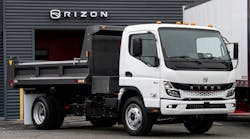The eight Marine Terminal Operators at the Port of Oakland, CA officially launched the so-called “Port Truck Ban” program yesterday as required by the port. The program prohibits trucks with pre-1994 engines from accessing the port. It also bans trucks with 1994-2003 engines unless they are equipped with a California Air Resources Board (CARB)-verified, Level 3 diesel particulate filter. Drayage trucks must also be registered with CARB and equipped with the new RFID tags the port is using to verify compliance.
According to Bruce Wargo, coordinator of program compliance for the Oakland Marine Terminal Operators and president and CEO of Pier Pass, using RFID technology to get the job done made a very difficult task possible. “By using technology to identify trucks electronically through the use of RFID tags and then validating each one against the CARB Drayage Truck Registry for CARB compliance, 92% of the trucks were allowed into the port terminals on the first day,” he said. “We feel like that was an excellent start. By the second day, things were even better; some 94% of the trucks were cleared to enter the port area.”
The program impacts about 2,800 vehicles, Wargo said. As a truck approaches the port entrance, an RFID tag “reader” captures the truck’s number from its RFID tag and compares it to the approved data base. A green light tells the truck operator that he or she is cleared to enter; a red light signals that permission to enter has been denied.
The 77-page port truck regulation, officially named the Maritime Comprehensive Truck Management Program or CTMP, was adopted on June 16, 2009. Through the plan, the port “seeks to identify drayage trucks serving the Seaport, support regulations to reduce emissions of air pollutants, increase safety and security domain awareness, improve operations, reduce traffic and congestion and involve and educate all seaport stakeholders.”
The Clean Trucks component of the program, like other plan elements, includes a series of compliance deadlines for drayage truck operators serving the port, beginning in Sept. 2009 with registration in the CARB statewide drayage truck registry. It was not introduced to truckers until October, and the original effective date was postponed two weeks by CARB to permit motor carriers additional time to bring themselves into compliance with the port’s requirements.
The Port of Oakland also worked with its agency, business, and community partners to provide financial assistance in the form of grants to help truck operators meet the new CARB standards, which form the backbone of the new drayage truck requirements. The 8% of truck operators who found themselves turned away yesterday were also referred to on-the-spot help at a center in Oakland to help them identify and correct compliance problems.
“People disenfranchised by the ban are obviously not happy about the program,” said Wargo, “but our assigned job is to implement the new requirements as best we can. Terminal operators already had plenty to do and now they are clean air police, as well. By working together, we hope to bring a single, unified approach to regulatory compliance that eases the burden for terminal operators and truck operators alike.”


